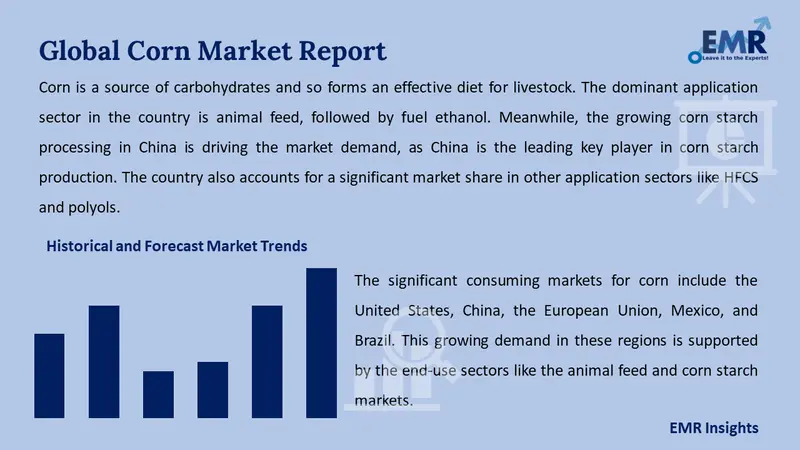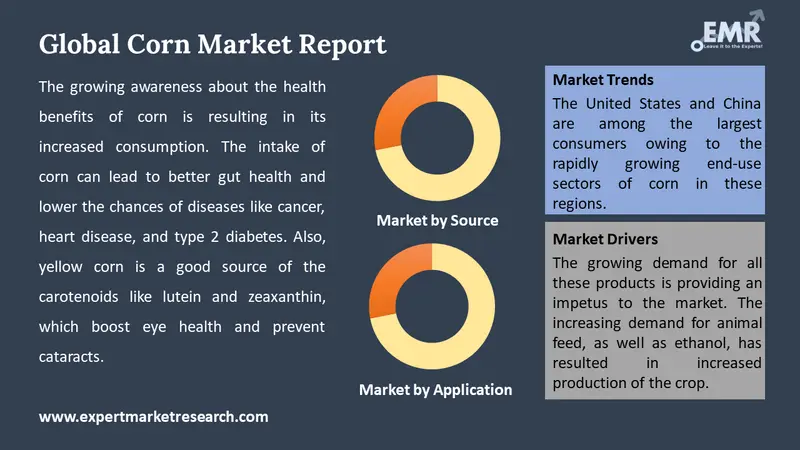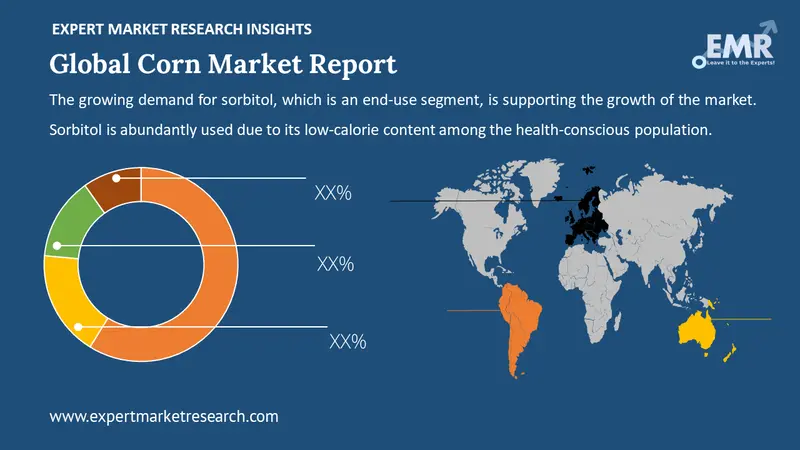Reports
Sale

Global Corn Market Size, Share, Value, Outlook, Forecast: By Source: Organic, Conventional; By Application: Food and Beverages, Animal Feed, Ethanol Production, Others; Regional Analysis; Market Dynamics: SWOT Analysis, Porter’s Five Forces Analysis; Trade Data Analysis; Key Trends and Developments in the Market; 2024-2032
Global Corn Market Outlook
The global corn market size reached a volume of 1183.43 million metric tons in 2023. The market is expected to grow at a CAGR of 1.1% between 2024 and 2032.
Corn refers to the yellow or white corn seeds, used mainly as livestock feed and as food for humans. It is also known as maize or Indian corn, a cereal plant belonging to the grass family called Poaceae, which has edible grain. The domesticated plant originated in the Americas, especially Mexico, and is among the most widely distributed food crops in the world.
The leafy stalk of the plant produces pollen inflorescences and separate ovuliferous inflorescences called ears that yield kernels or seeds, which are fruits. Corn is a staple food in many parts of the world and serves as a primary food source for humans, and livestock, and as raw material in many sectors.
Corn is remarkable for its productivity and its wide variety of uses. It can be eaten as a vegetable while still young or can be harvested when mature and used as a grain. It is a key ingredient in products like corn syrup, cornstarch, popcorn, and a vast array of other food and industrial products. Genetically, corn is highly diverse, allowing for adaptation to various climates and farming practices. Corn is not only a significant food source but also plays an integral role in economies, particularly in the agricultural and food sectors.

Read more about this report - REQUEST FREE SAMPLE COPY IN PDF
Key Trends of the Market
Economic growth in developing countries could lead to a rise in demand for corn and corn-based products and by-products
As the world population increases, so does the demand for food, including corn. Corn is a staple food in many parts of the world and a key ingredient in animal feed which boosts the corn market demand. An increasing population leads to greater demand for both direct human consumption and indirect consumption through meat and dairy products.
As developing countries experience economic growth, their citizens typically have more disposable income, which often leads to changes in dietary habits. There's usually an increase in the consumption of meat and dairy products, which in turn raises the demand for corn as animal feed. Additionally, improved economic conditions can lead to increased use of corn-based products and by-products.
Technological advancements in agricultural technology
Advances in genetic engineering are one of the crucial corn market trends that have led to the development of corn varieties that are more resistant to pests, diseases, and adverse weather conditions. Techniques like CRISPR gene editing are enabling more precise modifications to enhance traits like drought tolerance, nutrient efficiency, and growth rates. Traditional breeding methods, supported by genomic data, are also speeding up the development of new, more resilient varieties.
Farmers can use precision agriculture to tailor their practices to the specific needs of different parts of their fields, leading to more efficient use of resources. This includes the precise application of water, fertilisers, and pesticides, which not only boost yields but also minimise environmental impact.
Trade policies and agreements between major corn-producing and consuming countries
Lowering tariffs and other trade barriers on corn can propel the corn market growth, allowing exporting countries to sell more corn in the international market. This increased accessibility can lead to a rise in exports, benefiting major corn-producing countries.
Bilateral and multilateral trade agreements can create more favourable conditions for corn trade. For example, agreements that include provisions for agricultural products can open up new markets for corn exporters, boosting global trade volumes. Policies that promote sustainable and ethical farming practices can also impact the corn market. Consumers and businesses are increasingly demanding environmentally friendly and socially responsible products, which can shape trade flows and market preferences.

Read more about this report - REQUEST FREE SAMPLE COPY IN PDF
Corn Market Segmentation
The market is bifurcated on the basis of source into:
- Organic
- Conventional
Corn finds its applications in the following segments:
- Food and Beverages
- Animal Feed
- Ethanol Production
- Others
The EMR report also covers the regional markets of corn like North America, Europe, the Asia Pacific, Latin America, and the Middle East and Africa.
Rising corn production in the United States and China supports the market growth
The major corn producing countries include the United States, China, and Brazil, with the United States accounting for nearly 36% of the global corn market share. The United States is also responsible for over 36% of the global exports, followed by Brazil, Argentina, Ukraine, and Russia, as the other major exporters of the crop.
The significant consuming markets for corn include the United States, China, the European Union, Mexico, and Brazil. This growing demand in these regions is supported by the end-use sectors like the animal feed and corn starch markets. The United States and China are among the largest consumers owing to the rapidly growing end-use sectors of corn in these regions. The countries that rely on imports are Mexico, Japan, South Korea, the European Union, and Egypt. The rising demand for corn in the United States is due to the expansion of the feed and industrial sectors. Corn is a source of carbohydrates and so forms an effective diet for livestock. The dominant application sector in the country is animal feed, followed by fuel ethanol. Meanwhile, the growing corn starch processing in China is driving the market demand, as China is the leading key player in corn starch production. The country also accounts for a significant market share in other application sectors like HFCS and polyols.
Growing Demand in Various End-Use Sectors to Drive the Market Growth of Corn
The global corn market is being driven by the increasing applications of corn in various end-use sectors. Corn is widely used in the production of corn starch, which is further utilised in food ingredients, papers, ethanol, and sweeteners, among others. Corn is also used in the production of animal feed. The growing demand for all these products is providing an impetus to the market. The increasing demand for animal feed, as well as ethanol, has resulted in increased production of the crop. Corn is used in making biofuel because of the content of the starch present, and it can easily be converted into ethanol.
The rapidly rising demand for the product in the United States and China is mainly driven by the increasing use of the crop in various end-use sectors. The United States is a significant confectionery market, which is propelling the demand for corn starch owing to its use in sorbitol and sweeteners production.
The growing demand for sorbitol, which is an end-use segment, is supporting the growth of the market. Sorbitol is abundantly used due to its low-calorie content among the health-conscious population. Sorbitol has wide applications in personal care products and pharmaceuticals. The corn market is also being driven by the easy availability and low manufacturing cost of the product. The favourable policies of the government, as well as the increasing FDI flows for both pharmaceuticals and personal care products, have aided the growth of the market, especially in the Asia Pacific region. India and China represent the major emerging markets for the product in the Asia Pacific.
The growing awareness about the health benefits of corn is resulting in its increased consumption. The intake of corn can lead to better gut health and lower the chances of diseases like cancer, heart disease, and type 2 diabetes. Also, yellow corn is a good source of carotenoids like lutein and zeaxanthin, which boost eye health and prevent cataracts. The expanding production of corn, particularly in South Asian countries, due to their favourable geographical location and climatic conditions, is playing a critical role in the market development.
The steps taken by the governments to boost the production of maize are providing impetus to the market expansion. For instance, in May 2023, the Government of India announced to increase maize production, encouraging farmers for the same through various initiatives to meet the demand from diverse sectors like poultry and ethanol production. The ongoing research and development activities to enhance the corn yield and maximise profit are likely to aid the market over the forecast period.

Read more about this report - REQUEST FREE SAMPLE COPY IN PDF
Corn Market Analysis
There has been a significant increase in corn production, especially in major producing countries like the United States, driven by favourable weather conditions and improved yields. Innovations in agricultural technology, including precision agriculture and genetically modified crops, are enhancing production efficiency and crop resilience. Changing weather patterns due to climate change can affect crop yields, influencing supply and price volatility. The demand for corn in biofuel production, particularly ethanol, continues to impact the corn market value, linking it closely with the energy sector.
There might be an increased focus on sustainable corn production methods, balancing the need for high yields with environmental and social responsibilities. Trade policies, international relations, and geopolitical events can significantly influence global trade flows and pricing in the corn market.
The comprehensive EMR report provides an in-depth assessment of the market based on the Porter's five forces model along with giving a SWOT analysis.
Key Highlights of the Report
| Report Features | Details |
| Base Year | 2023 |
| Historical Period | 2018-2023 |
| Forecast Period | 2024-2032 |
| Scope of the Report |
Historical and Forecast Trends, Industry Drivers and Constraints, Historical and Forecast Market Analysis by Segment:
|
| Breakup by Source |
|
| Breakup by Application |
|
| Breakup by Region |
|
| Market Dynamics |
|
| Trade Data Analysis |
|
*At Expert Market Research, we strive to always give you current and accurate information. The numbers depicted in the description are indicative and may differ from the actual numbers in the final EMR report.
1 Preface
2 Report Coverage – Key Segmentation and Scope
3 Report Description
3.1 Market Definition and Outlook
3.2 Properties and Applications
3.3 Market Analysis
4 Key Assumptions
5 Executive Summary
5.1 Overview
5.2 Key Drivers
5.3 Key Developments
5.4 Key Industrial Trends
6 Market Snapshot
6.1 Global
6.2 Regional
7 Opportunities and Challenges in the Market
8 Global Corn Market Analysis
8.1 Key Industry Highlights
8.2 Global Corn Historical Production (2018-2023)
8.3 Global Corn Production Forecast (2024-2032)
8.4 Global Corn Historical Consumption (2018-2023)
8.5 Global Corn Consumption Forecast (2024-2032)
8.6 Global Corn Market by Source
8.6.1 Organic
8.6.1.1 Historical Trend (2018-2023)
8.6.1.2 Forecast Trend (2024-2032)
8.6.2 Conventional
8.6.2.1 Historical Trend (2018-2023)
8.6.2.2 Forecast Trend (2024-2032)
8.7 Global Corn Market by Application
8.7.1 Food and Beverages
8.7.1.1 Historical Trend (2018-2023)
8.7.1.2 Forecast Trend (2024-2032)
8.7.2 Animal Feed
8.7.2.1 Historical Trend (2018-2023)
8.7.2.2 Forecast Trend (2024-2032)
8.7.3 Ethanol Production
8.7.3.1 Historical Trend (2018-2023)
8.7.3.2 Forecast Trend (2024-2032)
8.7.4 Others
8.8 Global Corn Market by Region
8.8.1 North America
8.8.1.1 Historical Production (2018-2023)
8.8.1.2 Production Forecast (2024-2032)
8.8.1.3 Historical Consumption (2018-2023)
8.8.1.4 Consumption Forecast (2024-2032)
8.8.2 Europe
8.8.2.1 Historical Production (2018-2023)
8.8.2.2 Production Forecast (2024-2032)
8.8.2.3 Historical Consumption (2018-2023)
8.8.2.4 Consumption Forecast (2024-2032)
8.8.3 Asia Pacific
8.8.3.1 Historical Production (2018-2023)
8.8.3.2 Production Forecast (2024-2032)
8.8.3.3 Historical Consumption (2018-2023)
8.8.3.4 Consumption Forecast (2024-2032)
8.8.4 Latin America
8.8.4.1 Historical Production (2018-2023)
8.8.4.2 Production Forecast (2024-2032)
8.8.4.3 Historical Consumption (2018-2023)
8.8.4.4 Consumption Forecast (2024-2032)
8.8.5 Middle East and Africa
8.8.5.1 Historical Production (2018-2023)
8.8.5.2 Production Forecast (2024-2032)
8.8.5.3 Historical Consumption (2018-2023)
8.8.5.4 Consumption Forecast (2024-2032)
9 North America Corn Market Analysis
9.1 Market by Source
9.2 Market by Application
9.3 Market by Country
9.3.1 United States of America
9.3.1.1 Historical Trend (2018-2023)
9.3.1.2 Forecast Trend (2024-2032)
9.3.2 Canada
9.3.2.1 Historical Trend (2018-2023)
9.3.2.2 Forecast Trend (2024-2032)
10 Europe Corn Market Analysis
10.1 Market by Source
10.2 Market by Application
10.3 Market by Country
10.3.1 United Kingdom
10.3.1.1 Historical Trend (2018-2023)
10.3.1.2 Forecast Trend (2024-2032)
10.3.2 Germany
10.3.2.1 Historical Trend (2018-2023)
10.3.2.2 Forecast Trend (2024-2032)
10.3.3 France
10.3.3.1 Historical Trend (2018-2023)
10.3.3.2 Forecast Trend (2024-2032)
10.3.4 Italy
10.3.4.1 Historical Trend (2018-2023)
10.3.4.2 Forecast Trend (2024-2032)
10.3.5 Others
11 Asia Pacific Corn Market Analysis
11.1 Market by Source
11.2 Market by Application
11.3 Market by Country
11.3.1 China
11.3.1.1 Historical Trend (2018-2023)
11.3.1.2 Forecast Trend (2024-2032)
11.3.2 Japan
11.3.2.1 Historical Trend (2018-2023)
11.3.2.2 Forecast Trend (2024-2032)
11.3.3 India
11.3.3.1 Historical Trend (2018-2023)
11.3.3.2 Forecast Trend (2024-2032)
11.3.4 ASEAN
11.3.4.1 Historical Trend (2018-2023)
11.3.4.2 Forecast Trend (2024-2032)
11.3.5 South Korea
11.3.5.1 Historical Trend (2018-2023)
11.3.5.2 Forecast Trend (2024-2032)
11.3.6 Australia
11.3.6.1 Historical Trend (2018-2023)
11.3.6.2 Forecast Trend (2024-2032)
11.3.7 Others
12 Latin America Corn Market Analysis
12.1 Market by Source
12.2 Market by Application
12.3 Market by Country
12.3.1 Brazil
12.3.1.1 Historical Trend (2018-2023)
12.3.1.2 Forecast Trend (2024-2032)
12.3.2 Argentina
12.3.2.1 Historical Trend (2018-2023)
12.3.2.2 Forecast Trend (2024-2032)
12.3.3 Mexico
12.3.3.1 Historical Trend (2018-2023)
12.3.3.2 Forecast Trend (2024-2032)
12.3.4 Others
13 Middle East and Africa Corn Market Analysis
13.1 Market by Source
13.2 Market by Application
13.3 Market by Country
13.3.1 Saudi Arabia
13.3.1.1 Historical Trend (2018-2023)
13.3.1.2 Forecast Trend (2024-2032)
13.3.2 United Arab Emirates
13.3.2.1 Historical Trend (2018-2023)
13.3.2.2 Forecast Trend (2024-2032)
13.3.3 Nigeria
13.3.3.1 Historical Trend (2018-2023)
13.3.3.2 Forecast Trend (2024-2032)
13.3.4 South Africa
13.3.4.1 Historical Trend (2018-2023)
13.3.4.2 Forecast Trend (2024-2032)
13.3.5 Others
14 Market Dynamics
14.1 SWOT Analysis
14.1.1 Strengths
14.1.2 Weaknesses
14.1.3 Opportunities
14.1.4 Threats
14.2 Porter’s Five Forces Analysis
14.2.1 Supplier’s Power
14.2.2 Buyer’s Power
14.2.3 Threat of New Entrants
14.2.4 Degree of Rivalry
14.2.5 Threat of Substitutes
14.3 Key Indicators for Demand
14.4 Key Indicators for Price
15 Value Chain Analysis
16 Trade Data Analysis (HS Code - 1005)
16.1 Major Importing Countries
16.1.1 By Volume
16.1.2 By Value
16.2 Major Exporting Countries
16.2.1 By Volume
16.2.2 By Value
17 Price Analysis
17.1 North America Historical Price Trends (2018-2023) and Forecast (2024-2032)
17.2 Europe Historical Price Trends (2018-2023) and Forecast (2024-2032)
17.3 Asia Pacific Historical Price Trends (2018-2023) and Forecast (2024-2032)
17.4 Latin America Historical Price Trends (2018-2023) and Forecast (2024-2032)
17.5 Middle East and Africa Historical Price Trends (2018-2023) and Forecast (2024-2032)
18 Key Trends and Developments in the Market
List of Key Figures and Tables
1. Global Corn Market: Key Industry Highlights, 2018 and 2032
2. Global Corn Historical Market: Breakup by Source (MMT), 2018-2023
3. Global Corn Market Forecast: Breakup by Source (MMT), 2024-2032
4. Global Corn Historical Market: Breakup by Application (MMT), 2018-2023
5. Global Corn Market Forecast: Breakup by Application (MMT), 2024-2032
6. Global Corn Historical Market: Breakup by Region (MMT), 2018-2023
7. Global Corn Market Forecast: Breakup by Region (MMT), 2024-2032
8. North America Corn Historical Market: Breakup by Country (MMT), 2018-2023
9. North America Corn Market Forecast: Breakup by Country (MMT), 2024-2032
10. Europe Corn Historical Market: Breakup by Country (MMT), 2018-2023
11. Europe Corn Market Forecast: Breakup by Country (MMT), 2024-2032
12. Asia Pacific Corn Historical Market: Breakup by Country (MMT), 2018-2023
13. Asia Pacific Corn Market Forecast: Breakup by Country (MMT), 2024-2032
14. Latin America Corn Historical Market: Breakup by Country (MMT), 2018-2023
15. Latin America Corn Market Forecast: Breakup by Country (MMT), 2024-2032
16. Middle East and Africa Corn Historical Market: Breakup by Country (MMT), 2018-2023
17. Middle East and Africa Corn Market Forecast: Breakup by Country (MMT), 2024-2032
18. Major Importing Countries by Volume
19. Major Exporting Countries by Volume
20. Major Importing Countries by Value
21. Major Exporting Countries by Value
22. North America Historical Price Trends and Forecast 2018-2028
23. Europe Historical Price Trends and Forecast 2018-2028
24. Asia Pacific Historical Price Trends and Forecast 2018-2028
25. Latin America Historical Price Trends and Forecast 2018-2028
26. Middle East and Africa Historical Price Trends and Forecast 2018-2028
In 2023, the global corn market attained a volume of nearly 1183.43 million metric tons.
The market is projected to grow at a CAGR of 1.1% between 2024 and 2032.
The market is being driven by the growing demand for sorbitol and the rising use of corn in end-use industries, such as personal care and pharmaceuticals, among others.
The key trends guiding the market include the rising demand for corn in the animal feed sector and the growing uses of corn as ethanol fuel.
The major regions in the industry are North America, Latin America, the Middle East and Africa, Europe, and the Asia Pacific.
The significant applications of corn include food and beverages, animal feed, and ethanol production, among others.
The major sources of corn are organic and conventional.
Mini Report
-
Selected Sections, One User
-
Printing Not Allowed
-
Email Delivery in PDF
-
Free Limited Customisation -
Post Sales Analyst Support -
50% Discount on Next Update
Single User License
-
All Sections, One User
-
One Print Allowed
-
Email Delivery in PDF
-
Free Limited Customisation -
Post Sales Analyst Support -
50% Discount on Next Update

Five User License
-
All Sections, Five Users
-
Five Prints Allowed
-
Email Delivery in PDF
-
Free Limited Customisation
-
Post Sales Analyst Support
-
50% Discount on Next Update
Corporate License
-
All Sections, Unlimited Users
-
Unlimited Prints Allowed
-
Email Delivery in PDF + Excel
-
Free Limited Customisation
-
Post Sales Analyst Support
-
50% Discount on Next Update
Any Question? Speak With An Analyst
View A Sample
Did You Miss Anything, Ask Now
Right People
We are technically excellent, strategic, practical, experienced and efficient; our analysts are hand-picked based on having the right attributes to work successfully and execute projects based on your expectations.
Right Methodology
We leverage our cutting-edge technology, our access to trusted databases, and our knowledge of the current models used in the market to deliver you research solutions that are tailored to your needs and put you ahead of the curve.
Right Price
We deliver in-depth and superior quality research in prices that are reasonable, unmatchable, and shows our understanding of your resource structure. We, additionally, offer attractive discounts on our upcoming reports.
Right Support
Our team of expert analysts are at your beck and call to deliver you optimum results that are customised to meet your precise needs within the specified timeframe and help you form a better understanding of the industry.


